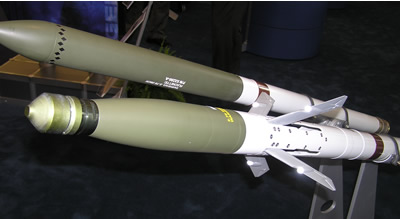The Low Cost Precision Guided Rocket concept has evolved as a response to a US Army Low-Cost Precision Kill initiative, started in 1996. The idea was simple – strap a laser seeker on a 2.75″ Hydra 70 rocket. Originally, Hydra 70 was originally designed as a family of rockets, used for area suppression, but with additional sophistication, it is transformed into a high precision, low-cost weapon, which provides the precision of a hellfire missile with significantly less collateral damage. The rocket’s blast-fragmentation warhead is also more suitable for urban warfare and low-intensity conflict.
 General Dynamics Armament and Technical Products and BAE Systems designed the M151Guided Warhead Block I modification for the 70mm rocket. This warhead retains the same fuse and warhead section of the standard M151, adding a mid-section which includes four semi-active laser seekers are embedded in the wing roots of forward canards, which are used for flight control. The Distributed Aperture Semi-Active Laser Seeker (DASALS) technology utilizes an array of four fixed detectors, which provide the same accuracy at a lower cost, compared to a gimbaled seeker. The complete assembly is emplaced between the warhead and rocket motor assemblies. The modified warhead length is extended from 4.2 cm to 90.9 and increase in weight from 4.2kg to 8.9kg. M151 Block I is currently under development and is scheduled to enter low rate initial production by 2006. Subsequent improvements of other Hydra 70 warheads and elements are planned for future production blocks.
General Dynamics Armament and Technical Products and BAE Systems designed the M151Guided Warhead Block I modification for the 70mm rocket. This warhead retains the same fuse and warhead section of the standard M151, adding a mid-section which includes four semi-active laser seekers are embedded in the wing roots of forward canards, which are used for flight control. The Distributed Aperture Semi-Active Laser Seeker (DASALS) technology utilizes an array of four fixed detectors, which provide the same accuracy at a lower cost, compared to a gimbaled seeker. The complete assembly is emplaced between the warhead and rocket motor assemblies. The modified warhead length is extended from 4.2 cm to 90.9 and increase in weight from 4.2kg to 8.9kg. M151 Block I is currently under development and is scheduled to enter low rate initial production by 2006. Subsequent improvements of other Hydra 70 warheads and elements are planned for future production blocks.
The Guided APKWS technology demonstration program was launched in 2002 and until September 2004 completed five flight tests, hitting targets at ranges of 1,500 to 5,500 meters.


















